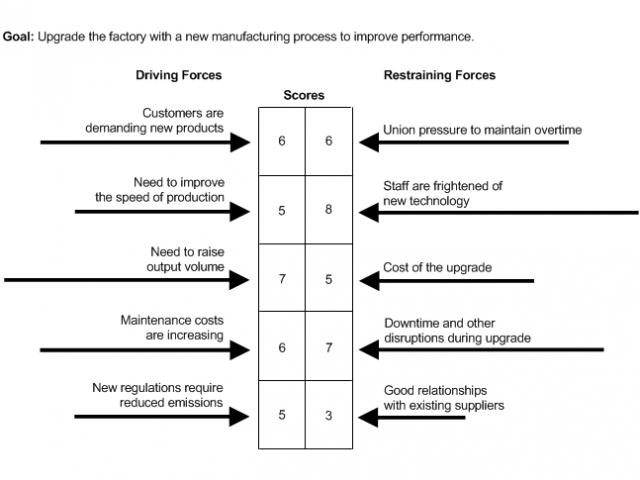The best way to understand Force field analysis is to go through the steps for using the tool as you look at an example. Figure 1 is an example of a Force field analysis for a manufacturing business.
Steps for using the tool
- Draw up a scorecard like in Figure 1, or use the worksheet in the 'Documents' section on the far right.
- Write the goal at the top.
- Think about the forces that will help the goal to be achieved. These are the driving forces.
- Write the driving forces on the left side of the scorecard, like in Figure 1.
- Think about the forces that will work against the goal being achieved. These are the restraining forces.
- Write the restraining forces on the right side of the scorecard.
- Score the strength of each of the forces from 1 to 10, for example, 1= weak, 5 = medium, 10 = strong. Put the scores in the boxes beside the forces. A high score for a restraining force means the force could make it very difficult to achieve the goal. A high score for a driving force means the force will make it much easier to achieve the goal.
- You can draw arrows under the forces to show the strengths. A strong force will have a long arrow, while a weak force will have a short arrow.
- Work out which are the highest priority forces to work on. This could mean strenghtening driving forces or reducing restraining forces. The person who invented Force field analysis, Kurt Lewin, said it was better to reduce restraining forces, not just strengthen driving forces.
- Develop action plans to manage the high priority forces.

Other tools to use with Force field analysis
Force field analysis can be used in step 4 of the CI&I - Continuous improvement and innovation process.
Once the high priority forces have been identified, a How-how diagram can be used to work out how to manage the forces.
The Action design tool or Five Ws and one H can be used to plan action to manage the high priority forces.
Support to use the tool
Please contact us if you would like help to use Force field analysis.
A worksheet to help you use the tool can be found in the 'Documents' section on the far right.
